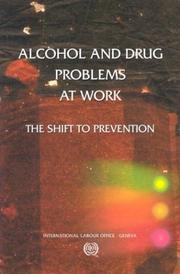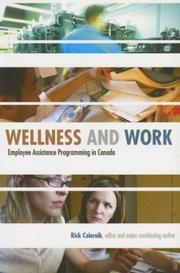| Listing 1 - 7 of 7 |
Sort by
|
Multi
ISBN: 9781501717895 1501717898 9780875461670 Year: 1990 Publisher: Ithaca, N.Y.
Abstract | Keywords | Export | Availability | Bookmark
 Loading...
Loading...Choose an application
- Reference Manager
- EndNote
- RefWorks (Direct export to RefWorks)
This Key Issues report addresses questions often raised by employers and union leaders setting out to develop job-based programs to help alcoholic and other troubled employees.Following chapters on the historical development and key components of EAPs, the authors discuss the importance of balance in program strategies and in corporate and union responsibilities. The authors also present examples to show the role EAPs might play when the problems of alcoholic and other troubled employees lead to arbitration and workers' compensation cases. The focus in the concluding chapter is on the future of EAPs—the need for more research and further development of educational programs for EAP practitioners.
Economics --- Alcoholism and employment. --- Employee assistance programs.

ISBN: 1501717898 9781501717895 0875461670 Year: 2018 Publisher: Ithaca : Baltimore, Md. : Cornell University Press, Project MUSE,
Abstract | Keywords | Export | Availability | Bookmark
 Loading...
Loading...Choose an application
- Reference Manager
- EndNote
- RefWorks (Direct export to RefWorks)
This Key Issues report addresses questions often raised by employers and union leaders setting out to develop job-based programs to help alcoholic and other troubled employees.Following chapters on the historical development and key components of EAPs, the authors discuss the importance of balance in program strategies and in corporate and union responsibilities. The authors also present examples to show the role EAPs might play when the problems of alcoholic and other troubled employees lead to arbitration and workers' compensation cases. The focus in the concluding chapter is on the future of EAPs—the need for more research and further development of educational programs for EAP practitioners.
Employee assistance programs. --- Alcoholism and employment. --- BUSINESS & ECONOMICS / Labor. --- Employment and alcoholism --- Personnel management --- Employee assistance programs --- Behavioral assistance programs --- Troubled employee programs --- Alcoholism and employment --- Drugs and employment
Book
ISBN: 9781869227388 1869227387 1869227379 9781869227371 Year: 2018 Publisher: Randberg, South Africa
Abstract | Keywords | Export | Availability | Bookmark
 Loading...
Loading...Choose an application
- Reference Manager
- EndNote
- RefWorks (Direct export to RefWorks)
Book
ISBN: 1631177761 1631177613 9781631177767 9781631177613 Year: 2014 Publisher: Hauppauge, New York
Abstract | Keywords | Export | Availability | Bookmark
 Loading...
Loading...Choose an application
- Reference Manager
- EndNote
- RefWorks (Direct export to RefWorks)
Substance abusers exert a significant cost burden for employers. Evidence is mounting that worker substance abuse may have its greatest impact on productivity losses including increased absenteeism and short-term disability, higher turnover, and suboptimal performance at work. Full-time workers that reported using illicit drugs or abusing prescribed drugs were more likely to report missing two or more workdays in the past month due to illness or injury and were more likely to have skipped one or more days of work in the past month. But what does one do to address this situation? The response i
Drugs and employment -- United States. --- Employees -- Alcohol use -- United States. --- Industrial hygiene -- United States. --- Drugs and employment --- Employees --- Industrial hygiene --- Commerce --- Business & Economics --- Marketing & Sales --- Alcohol use --- Laborers --- Personnel --- Workers --- Persons --- Industrial relations --- Personnel management --- Alcoholism and employment --- E-books

ISBN: 9221133737 Year: 2003 Publisher: Geneva : ILO,
Abstract | Keywords | Export | Availability | Bookmark
 Loading...
Loading...Choose an application
- Reference Manager
- EndNote
- RefWorks (Direct export to RefWorks)
Alcoholism and employment --- Drugs and employment --- Substance abuse --- Alcoolisme et travail --- Drogues et travail --- Polytoxicomanie --- Prevention --- Prévention --- AA / International- internationaal --- 658.332 --- Hygiëne. Arbeidsveiligheid. Comfort. --- Prévention --- Abuse of substances --- Addiction, Substance --- Addictive behavior --- Chemical dependence --- Chemical dependency --- Substance addiction --- Substance dependence --- Substance-related disorders --- Substance use disorders --- Psychology, Pathological --- Drug abuse and employment --- Employees --- Employment and drugs --- Employee assistance programs --- Employment and alcoholism --- Personnel management --- Hygiëne. Arbeidsveiligheid. Comfort --- Drug use

ISBN: 1459322363 1435604156 9781435604155 1551302764 9781551302768 9781459322363 1551308444 9781551308449 Year: 2005 Publisher: Toronto Canadian Scholars Press
Abstract | Keywords | Export | Availability | Bookmark
 Loading...
Loading...Choose an application
- Reference Manager
- EndNote
- RefWorks (Direct export to RefWorks)
Employee assistance programs --- Industrial hygiene --- Occupational diseases --- Diseases of occupations --- Employees --- Industrial diseases --- Occupation diseases --- Occupations --- Work-related diseases --- Diseases --- Medicine, Industrial --- Health of workers --- Hygiene, Industrial --- Industrial health engineering --- Occupational health and safety --- Occupational safety and health --- Work environment --- Environmental health --- Industrial management --- Behavioral assistance programs --- Troubled employee programs --- Personnel management --- Alcoholism and employment --- Drugs and employment --- Health and hygiene --- Health aspects --- E-books

ISBN: 128230058X 9786612300585 1605092533 9781605092539 9781609943622 1609943627 1576754200 9781576754207 9781282300583 6612300582 Year: 2006 Publisher: San Francisco, Calif. : Berrett-Koehler,
Abstract | Keywords | Export | Availability | Bookmark
 Loading...
Loading...Choose an application
- Reference Manager
- EndNote
- RefWorks (Direct export to RefWorks)
Flood, fire, hurricane, earthquake, workplace violence, bombings, even the arrest or sudden death of the CEO—sooner or later, most organizations will face some sort of disaster. Leading People Through Disasters breaks new ground in disaster-recovery by focusing on supporting the people who keep the business running in times of crisis. Kathryn McKee and Liz Guthridge show how to ensure that your business continuity plan addresses human as well as business issues and they offer detailed advice on what to do when disaster actually strikes—how to keep people safe, calm, and informed; help managers care for employees; and deal with employees' immediate and ongoing emotional and psychological needs while getting the organization back on its feet. This comprehensive guide features a wealth of examples, checklists, forms, and other practical tools that will help you take action when you need it most.
Crisis management. --- Emergency management. --- Personnel management. --- Employee assistance programs. --- Consequence management (Emergency management) --- Disaster planning --- Disaster preparedness --- Disaster prevention --- Disaster relief --- Disasters --- Emergencies --- Emergency planning --- Emergency preparedness --- Management --- Public safety --- First responders --- Crises --- Management of crises --- Problem solving --- Conflict management --- Behavioral assistance programs --- Troubled employee programs --- Personnel management --- Alcoholism and employment --- Drugs and employment --- Corporations --- Employment management --- Human resource management --- Human resources management --- Manpower utilization --- Personnel administration --- Public administration --- Employees --- Employment practices liability insurance --- Supervision of employees --- Planning --- Preparedness --- Prevention --- Crisis management --- Emergency management --- Employee assistance programs --- E-books
| Listing 1 - 7 of 7 |
Sort by
|

 Search
Search Feedback
Feedback About UniCat
About UniCat  Help
Help News
News